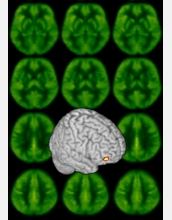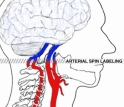News Release 05-203
Researchers Use Imaging Technique to Visualize Effects of Stress on Human Brain
Method tracks water molecules in blood

Blood flow in the brains of volunteers undergoing mental arithmetic
November 22, 2005
This material is available primarily for archival purposes. Telephone numbers or other contact information may be out of date; please see current contact information at media contacts.
The holiday season is notorious for the emotional stress it evokes. Now, researchers at the University of Pennsylvania School of Medicine have come up with a non-invasive way to see the effects of psychological stress in an area of the brain linked to anxiety and depression. This research has important implications for how practitioners treat the numerous long-term health consequences of chronic stress.
In the study, which is reported in the Nov.21 online edition of the Proceedings of the National Academy of Sciences, researchers used functional magnetic resonance imaging (fMRI) to detect an increase in blood flow to the prefrontal cortex in individuals subjected to stress. Further, the increase remained even when the stressor was removed, suggesting the effects of stress are more persistent than once thought.
Whereas most previous fMRI studies have relied on indirect measures of cerebral blood flow, the Penn team, led by John A. Detre, measured blood flow directly, using a technique called arterial spin labeling. The technique is non-invasive, relying on magnetically "tagging" the water molecules in subjects' blood.
This research is supported by the National Science Foundation, the National Institutes of Health, and the U.S. Air Force.
For a complete story, see the University of Pennsylvania release.
-NSF-
-
Arterial spin labeling uses an fMRI magnet to "tag" water molecules in the patient's blood
Credit and Larger Version
Media Contacts
Mitch Waldrop, NSF, 703-292-7752, email: mwaldrop@nsf.gov
Olivia Fermano, University of Pennsylvania, 215-349-5653, email: olivia.fermano@uphs.upenn.edu
The U.S. National Science Foundation propels the nation forward by advancing fundamental research in all fields of science and engineering. NSF supports research and people by providing facilities, instruments and funding to support their ingenuity and sustain the U.S. as a global leader in research and innovation. With a fiscal year 2023 budget of $9.5 billion, NSF funds reach all 50 states through grants to nearly 2,000 colleges, universities and institutions. Each year, NSF receives more than 40,000 competitive proposals and makes about 11,000 new awards. Those awards include support for cooperative research with industry, Arctic and Antarctic research and operations, and U.S. participation in international scientific efforts.
Connect with us online
NSF website: nsf.gov
NSF News: nsf.gov/news
For News Media: nsf.gov/news/newsroom
Statistics: nsf.gov/statistics/
Awards database: nsf.gov/awardsearch/
Follow us on social
Twitter: twitter.com/NSF
Facebook: facebook.com/US.NSF
Instagram: instagram.com/nsfgov



